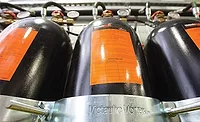PM Announces Results Of Internet, Fire Protection Surveys
The Internet survey was a collaboration with the Plumbing Manufacturers Institute, which wanted to analyze the Internet habits among players in the traditional channel of distribution.
"There's been all this hype about e-commerce," says Ralph Herrbach, president of faucet maker Cifial USA, and current PMI president. Herrbach was also instrumental in developing the survey's 20-plus questions. "Before small and medium-sized manufacturers invest in this technology, we needed to understand how our customers were using this new form of media."
Last year, we sent a survey to 1,000 randomly selected readers of this magazine, as well as the same number of subscribers of Supply House Times and PM Engineer. The response rates for each was in the mid-teens.
While it may not be a surprise that contractors, wholesalers and specifiers had different answers to the same questions, Herrbach says he was surprised to see the similarities regarding getting the most out of the Internet, and, in particular, what information they want that's currently not available to them on the Internet.
A common demand from all three groups for information not available on the Internet was for detailed product information. According to Herrbach's own analysis of the numbers, each group defined "detailed" differently. Contractors, for example, wanted "easy-to-access" product information, which Herrbach believes means information on a Web site with an easy-to-use graphical interface. Meanwhile, distributors wanted "current" technical data, such as specification and installation manuals. Finally, specifiers were looking for CAD-based drawings.
In addition, a recent survey of PM readers found about as many different methods of installing fire protection systems as there are contractors to do the work.
Last fall, we sent a survey to 1,000 PM readers. We received a 14 percent return rate, with 92.5 percent indicating they are involved in the fire protection industry.
"My first thought was that the responses for most, if not all, the questions are all over the board," says Mark Broman, SET, CFPS, president of Flex Fire Protection Design and PM Engineer fire protection columnist. Broman also helped craft the questions we asked. "Not every contractor does things the same way, and there are no clear winners in looking at the answers."
For example, a third of the respondents said that less than 10 percent of their working drawings were prepared in CAD, another third indicated that three-quarters to 100 percent of their work was done in CAD, and the remaining respondents break down into single-digit responses.
Since our readers have their own way of doing things, one reason may be the lack of coherence in the information they're given to prepare the job. Averaged out, one in every three respondents said that preliminary plans and specs "contain so many deficiencies/inconstancies as to render them virtually useless."
If the survey did indicate any trends, Broman suggested two: the continued decline of using galvanized piping in dry-pipe installations, and the continued acceptance of outsourcing prefab that may have been done in-house in the past.
Pricing for the surveys is as follows:
- For the Internet survey, each of the three surveys can be purchased for $95, or all three surveys can be purchased for $250.
- Copies of the fire protection survey can be purchased for $95.
More information, including charts from just some of the key questions, can be found at www.PMmag.com or contact Lisa Frost at 248/244-1290, frostl@bnp.com.
Looking for a reprint of this article?
From high-res PDFs to custom plaques, order your copy today!






